Megami Tensei, marketed internationally as Shin Megami Tensei, is a Japanese media franchise created by Aya Nishitani, Kouji "Cozy" Okada, Ginichiro Suzuki, and Kazunari Suzuki. Primarily developed and published by Atlus, and currently owned by Atlus, the franchise consists of multiple subseries and covers multiple role-playing genres including tactical role-playing, action role-playing, and massively multiplayer online role-playing. The first two titles in the series were published by Namco, but have been almost always published by Atlus in Japan and North America since the release of Shin Megami Tensei. For Europe, Atlus publishes the games through third-party companies.
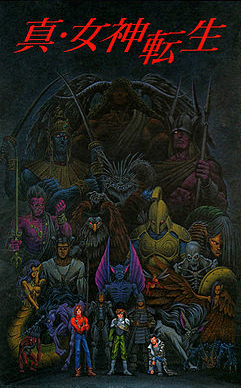
Shin Megami Tensei is a role-playing video game developed and published by Atlus for the Super Famicom. Originally released in 1992 in Japan, it has been ported to multiple systems and eventually released in the West for iOS in 2014. It was released on the Virtual Console service in Japan on Wii in 2007 and on Wii U in 2013, as well as Nintendo Switch Online in 2020. It is the third game in the Megami Tensei series and the first in the central Shin Megami Tensei series. The gameplay uses first-person navigation of dungeons and turn-based battles against demons. The player can recruit demons as allies by talking to them rather than fighting them, and two to three demons can be fused to create new demons.

A saved game is a piece of digitally stored information about the progress of a player in a video game.
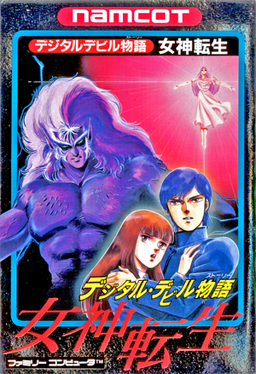
Digital Devil Story: Megami Tensei refers to two distinct role-playing video games based on a trilogy of science fantasy novels by Japanese author Aya Nishitani. One version was developed by Atlus and published by Namco in 1987 for the Famicom—Atlus would go on to create further games in the Megami Tensei franchise. A separate version for personal computers was co-developed by Atlus and Telenet Japan and published by Telenet Japan during the same year. An enhanced port for the Super Famicom by Opera House was released in 1995.

Digital Devil Story: Megami Tensei II is a role-playing video game developed by Atlus and published by Namco for the Famicom. An enhanced Super Famicom port was developed by Opera House and released by Atlus in 1995. The second entry in the Megami Tensei series, the gameplay features the unnamed protagonist exploring a post-apocalyptic wasteland, battling and recruiting demons as they are pushed into taking part in a conflict between the demonic forces of Lucifer and the army of the One True God.

Shin Megami Tensei III: Nocturne is a role-playing video game developed by Atlus for the PlayStation 2. It was published by Atlus in Japan and North America, and by Ghostlight in Europe. It is the third numbered entry in the Shin Megami Tensei series, the central series in the Megami Tensei franchise. Multiple versions of the game have been published: the original version was published in Japan by Atlus in 2003, while a director's cut was released in 2004 in Japan. The director's cut was localized and released in North America in 2004 as Shin Megami Tensei: Nocturne and in PAL regions in 2005 as Shin Megami Tensei: Lucifer's Call. A high-definition remaster was released for the Nintendo Switch and PlayStation 4 in Japan in 2020, and was internationally released in 2021 on those consoles and Windows.

Shin Megami Tensei: Digital Devil Saga is a duology of role-playing video games developed by Atlus for the PlayStation 2. They are a spin-off of the Megami Tensei series. The first Digital Devil Saga was released in Japan in 2004, North America in 2005, and Europe in 2006. Its direct sequel, Shin Megami Tensei: Digital Devil Saga 2, released in 2005 in Japan and North America, and 2007 in Europe. The games were published in Europe by Ghostlight and in other regions by Atlus and its North American subsidiary Atlus USA.

Shin Megami Tensei If..., stylized as Shin Megami Tensei if…, is a role-playing video game developed and published by Atlus in 1994 for the Super Famicom. It is a spin-off from the Shin Megami Tensei series, itself part of the larger Megami Tensei franchise. Since release, it has been ported to mobile devices, PlayStation and Microsoft Windows; it had also been re-released on the Virtual Console in Japan on Wii in 2011 and Wii U in 2013, as well as Nintendo Switch Online in 2021. The story follows a student of Karukozaka High School after their school is sucked into the realm of demons by a vengeful student's demon summoning spell going wrong.

Majin Tensei is a series of strategy video games published by Atlus. It is a spin-off from Atlus' Megami Tensei franchise, and began with 1994's Majin Tensei. Since then, four further titles have been released: Majin Tensei II: Spiral Nemesis (1995), Ronde (1997), Majin Tensei: Blind Thinker (2007) and Majin Tensei: Blind Thinker II (2008). The player navigates a field seen from a top-down or three-quarters perspective as a human character, and battles demons; they can also recruit demons, and fuse multiple allied demons to create new, stronger demons.

Shin Megami Tensei: Devil Summoner is a role-playing video game developed and published by Atlus. Forming part of the Megami Tensei franchise, it is the first title in the Devil Summoner series. It was first released for the Sega Saturn in December 1995, and received a port to the PlayStation Portable in December 2005. Despite reports of it being planned for localization, neither version has been released outside Japan.
Cheating in video games involves a video game player using various methods to create an advantage beyond normal gameplay, usually in order to make the game easier. Cheats may be activated from within the game itself, or created by third-party software or hardware. They can also be realized by exploiting software bugs; this may or may not be considered cheating based on whether the bug is considered common knowledge.

Megami Tensei Gaiden: Last Bible is a role-playing video game series developed by Multimedia Intelligence Transfer, Sega, and Menue, and published by Atlus and Sega for multiple platforms. The first game of the series, Revelations: The Demon Slayer, was released in 1992; this is the only title in the series to have been released in English. After The Demon Slayer, two sequels and five spin-off titles have been released. In the main series titles, players explore the game world and fight monsters in menu-based battles; players can also attempt to recruit monsters to their party, and can fuse two allied monsters into a single new one to try to get stronger monsters. The spin-off title Another Bible is a turn-based strategy game, while Last Bible Special is a role-playing game controlled from a first-person perspective.
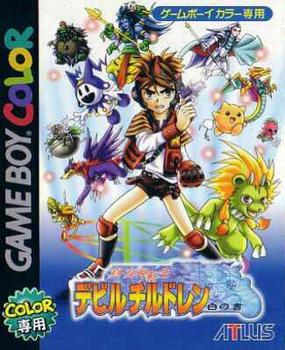
Shin Megami Tensei: Devil Children, also known as DemiKids, is a series of role-playing video games primarily developed by Multimedia Intelligence Transfer and published by Atlus. It is a spin-off from Atlus' Megami Tensei franchise, and began in 2000 with the Game Boy Color games Black Book and Red Book. Five more role-playing games and three games in other genres were released until 2004, followed by no new releases until the 2011 social game Shin Megami Tensei: Devil Children. In addition to the games, the series has been adapted into manga, anime, and a trading card game, and two soundtrack albums have been released by First Smile Entertainment.

Shin Megami Tensei NINE is a Japanese role-playing video game developed by Atlus and NexTech for the Xbox, and published by Atlus on December 5, 2002.

Shin Megami Tensei: Devil Survivor is a tactical role-playing video game in the Megami Tensei series developed by Atlus for the Nintendo DS. It was released in Japan on January 15, 2009, and in North America on June 23, 2009. An enhanced port for the Nintendo 3DS, Shin Megami Tensei: Devil Survivor Overclocked, was also developed by Atlus and released in 2011 for Japan and North America while in 2013 for Europe.

Shin Megami Tensei: Strange Journey is a role-playing video game developed by Atlus and Lancarse for the Nintendo DS. The game is the sixth entry in the Shin Megami Tensei series, which forms the core of the Megami Tensei franchise. It was released in Japan in 2009, and in North America in 2010. An enhanced port for the Nintendo 3DS, Shin Megami Tensei: Strange Journey Redux, was released in Japan in 2017, and was released internationally in 2018 by Atlus in North America and Deep Silver in Europe.
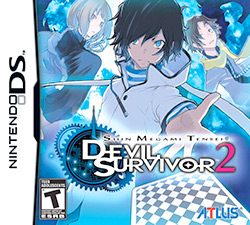
Shin Megami Tensei: Devil Survivor 2 is a tactical role-playing game in the Megami Tensei series developed by Atlus for the Nintendo DS. It is a sequel to the 2009 Nintendo DS role-playing game Shin Megami Tensei: Devil Survivor. It was released in Japan in July 2011, in North America in February 2012, and in Europe in October 2013. An enhanced version for the Nintendo 3DS, titled Shin Megami Tensei: Devil Survivor 2 Record Breaker, was released in 2015.

Shin Megami Tensei IV is a role-playing video game developed by Atlus for the Nintendo 3DS. It is part of the Shin Megami Tensei series, the central series of the Megami Tensei franchise, though no direct story connection exists to previous entries. It was released in May and July 2013 for Japan and North America respectively. It was released digitally in Europe in October 2014. The gameplay is reminiscent of previous Shin Megami Tensei games, carrying over the turn-based Press Turn battle system, where players and enemies fight and exploit weaknesses, allowing either side to gain additional turns or lose them.
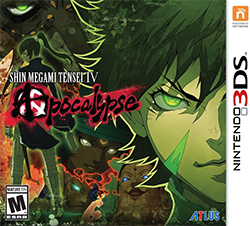
Shin Megami Tensei IV: Apocalypse is a 2016 role-playing video game developed and published by Atlus for the Nintendo 3DS. It is the sequel to Shin Megami Tensei IV, set in a post-apocalyptic alternative world. The game is part of the Shin Megami Tensei series, the central series of the Megami Tensei franchise. The game features gameplay mechanics from previous Shin Megami Tensei releases, such as the Press Turn battle system, where players and enemies fight and exploit weaknesses, allowing either side to gain additional turns or lose them.

Shin Megami Tensei: Liberation Dx2 is a role-playing video game developed and published by Sega for iOS and Android. It is part of Atlus' Shin Megami Tensei (SMT) series, which in turn is part of the larger Megami Tensei franchise. The plot follows a player-customised character who battles demons with a smartphone app. The game was presented in the 2017's Tokyo Game Show by SEGA and Atlus. It was initially released in January 2018, in Japan, Taiwan, Hong Kong and Macau, and later released worldwide. A mode similar to Pokémon Go was later added after the game's launch, showing demons in augmented reality.















